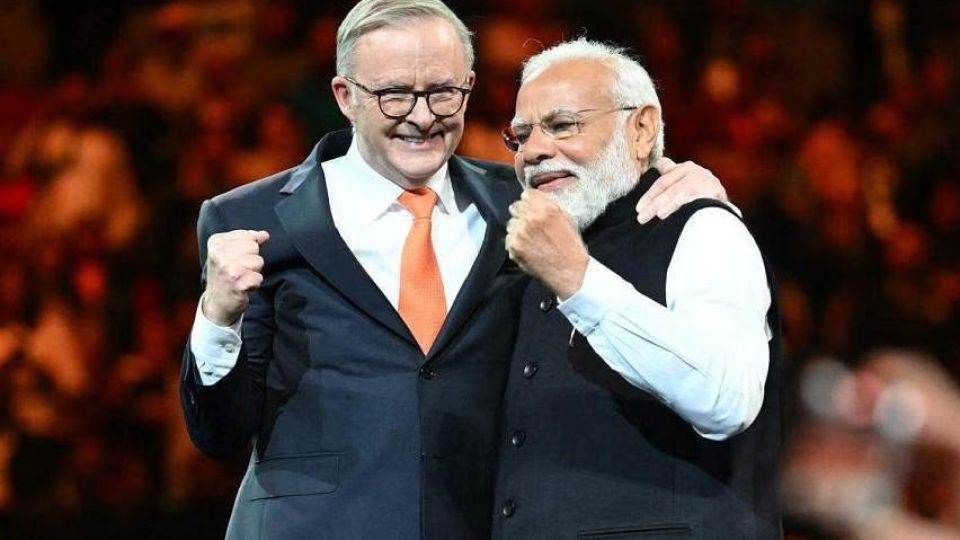May 24, 2023
SYDNEY – At an indoor stadium at Sydney Olympic Park – a venue that typically hosts concerts by stars such as Michael Buble and Lizzo – Indian Prime Minister Narendra Modi on Tuesday night received a rapturous welcome from 20,000 people that appeared to leave his Australian counterpart Anthony Albanese bemused.
“The last time I saw someone on the stage here was Bruce Springsteen – and he didn’t get the welcome that Prime Minister Modi has got,” Mr Albanese told the crowd.
As the skies above Sydney featured the sky-written message “Welcome Modi”, the Indian leader was greeted by crowds from across the country. Some arrived on a chartered flight from Melbourne rebranded “Modi Airways”, while others travelled from the cities of Brisbane and Canberra on “Modi Express” buses.
This welcome was largely a reflection of the speedy growth of Australia’s Indian diaspora community, which now includes more than 670,000 people born in India. In recent decades, India has been the largest source of permanent immigrants, ahead of China and Britain.
Mr Modi last visited Australia in 2014 – his first year in office. He is looking to a third term in office in 2024.
The fast-increasing community has helped make Australia an attractive destination for Indian leaders and raised hopes that the visit might deliver a much-needed boost to relations between New Delhi and Canberra. For years, the relationship was viewed as disappointing and underwhelming. Despite the two countries’ shared heritage as former British colonies and democracies with a passion for cricket, trade remained relatively weak, and security and diplomatic ties faced hurdles such as Canberra’s reservations about India’s nuclear weapons programme.
But all that has begun to change in recent years.
Mr Albanese pointed out in Parliament on Tuesday that he was elected just a year ago but has now met Mr Modi six times. Military cooperation has increased, and the two countries are both members of the Quad, a grouping that also includes the United States and Japan.
Trade has grown but remains relatively low – despite now having the world’s largest population, India was only Australia’s sixth-largest trading partner in 2022, just behind Singapore. But a long-awaited trade agreement finally entered into force in 2022 as an interim deal, which is expected to result in total trade more than doubling to about A$100 billion (S$89 billion) in five years.
There are two main reasons for this turnaround in the relationship. One is the Indian diaspora community, which has been helping to persuade policymakers in Canberra and Delhi to push for closer diplomatic and trade ties.
Addressing the crowd in Sydney on Tuesday, Mr Modi acknowledged the growing community links between the two countries.
“Mutual trust and respect have not developed only due to the diplomatic relations of India-Australia,” he said. “The real reason, the real power, is all of you Indians who live here in Australia.”
Likewise, Mr Albanese said: “I’m proud that you have made Australia your home. That you see your life and your future here… You make Australia stronger.”
The other reason for the growing bilateral ties is that both nations are increasingly wary about the rising military might and assertiveness of China.
In recent years, India has had a series of border skirmishes with China, while Canberra has been punished with trade sanctions and a diplomatic freeze following disputes with Beijing over issues such as Australia’s foreign interference laws and its calls for an inquiry into the origins of Covid-19.
This shared concern about China has been fuelling closer security ties. Aside from their membership of the Quad, the two countries have begun to hold regular military exercises as well as holding an annual leaders’ summit and a dialogue between the foreign and defence ministers at least every two years.

Members of the local Indian community listening to a speech by Indian PM Narendra Modi at the Qudos Bank Arena in Sydney on May 23. PHOTO: AFP
The former secretary of Australia’s Department of Foreign Affairs and Trade and former high commissioner to India, Mr Peter Varghese, said earlier in 2023 that Australia had long tried to deepen engagement with India, but with little success. However, recent geopolitical changes – particularly concerns about China – have helped to transform the relationship.
“For a long time, it was a one-sided relationship,” he told The Sydney Morning Herald. “We have now seen seriousness on the part of India to build the relationship.”
Mr Modi on Tuesday talked up the cultural ties between the two countries, including a shared passion for yoga, film and tennis.
But, in a more blunt description, Australia’s Deputy Prime Minister Richard Marles said the two countries have “never had a greater strategic alignment”.
“Both countries are deeply invested in the collective security of the Indo-Pacific region,” he told reporters. “And all of this is driving a much closer relationship.”


